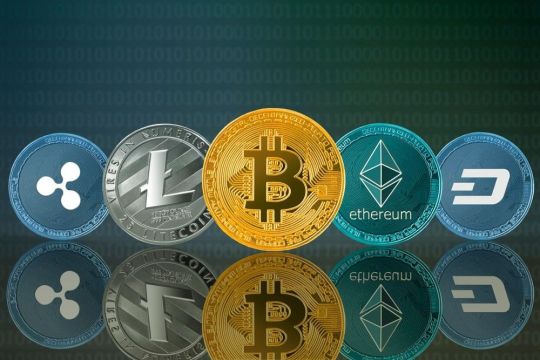#cbdc vs cryptocurrency
Text
#central bank digital currency#crypto currency wallet#blockchain technology in banking#CBDCs vs Cryptocurrencies
0 notes
Text
Join us on a fascinating exploration of the evolving landscape of digital money as we compare Central Bank Digital Currencies (CBDCs) with cryptocurrencies. Delve into the key differences, advantages, and challenges associated with both CBDCs and cryptocurrencies, shedding light on their potential impact on our financial systems and everyday lives. Discover the potential benefits of CBDCs, such as increased financial inclusion and improved transaction efficiency, while also exploring the decentralized nature and privacy aspects of cryptocurrencies. Whether you're a cryptocurrency enthusiast or simply intrigued by the future of money, this journey will provide valuable insights and inspire engaging discussions. Buckle up for an intriguing exploration of CBDCs vs cryptocurrencies - the future of digital money awaits!
#blockchain#cryptocurrency#crypto#green technology#technology#blockchain technology#bitcoin#metaverse#defi#nftnews#cbdc#digital currency#btc#ethereum#cryptocurrency news
2 notes
·
View notes
Text
The Crypto Revolution: Decoding the Secrets of Digital Money
Introduction:
In recent years, the world has witnessed an unprecedented revolution in the realm of finance with the emergence of cryptocurrencies. Digital money, led by Bitcoin and a multitude of other cryptocurrencies, has disrupted traditional financial systems and ignited a wave of innovation and speculation. Here are the best Local Bitcoin Clone Services of 2023.

As the crypto revolution continues to reshape our understanding of money, it becomes essential to unravel the secrets behind this transformative technology. Join us on a journey as we decode the mysteries of digital money and explore the implications it holds for the future of finance.
Chapter 1: Money Redefined 1.1
The Evolution of Currency: From Barter to Fiat 1.2 The Rise of Cryptocurrencies 1.3 Understanding the Concept of Digital Money 1.4 The Advantages and Challenges of Cryptocurrencies
Chapter 2: Blockchain:
The Backbone of Digital Money 2.1 Demystifying Blockchain Technology 2.2 Decentralization: The Power Shift 2.3 Security and Transparency in the Blockchain 2.4 Smart Contracts: Automating Trust
Chapter 3: Bitcoin:
The Pioneer 3.1 The Enigma of Satoshi Nakamoto 3.2 The Birth of Bitcoin 3.3 Mining and the Proof-of-Work Consensus 3.4 Bitcoin's Influence on the Cryptocurrency Ecosystem
Chapter 4: Altcoins and Tokenomics 4.1
Diversifying the Crypto Landscape 4.2 Ethereum and the Rise of Smart Contracts 4.3 Initial Coin Offerings (ICOs) and Token Sales 4.4 Utility Tokens vs. Security Tokens
Chapter 5: Crypto Exchanges and Trading 5.1
Centralized vs. Decentralized Exchanges 5.2 Trading Strategies and Market Volatility 5.3 Wallets and Security Best Practices 5.4 The Role of Regulation in Crypto Trading
Chapter 6: Decentralized Finance (DeFi) 6.1
Unleashing the Potential of Decentralized Finance 6.2 Decentralized Lending and Borrowing 6.3 Automated Market Making and Decentralized Exchanges 6.4 Yield Farming and Staking

Chapter 7: NFTs and the Digital Ownership Revolution 7.1
Non-Fungible Tokens (NFTs): Beyond Cryptocurrency 7.2 The Impact of NFTs on Art, Gaming, and Collectibles 7.3 Tokenizing Real-World Assets with NFTs 7.4 Challenges and Future Prospects of NFTs
Chapter 8: The Future of Digital Money 8.1
Central Bank Digital Currencies (CBDCs) 8.2 Interoperability: Bridging Blockchain Networks 8.3 Privacy and Security Enhancements 8.4 The Socioeconomic Impacts of Cryptocurrencies
Conclusion:
As we conclude our exploration of The Crypto Revolution and its secrets, we discover a world where digital money challenges the status quo and empowers individuals with newfound financial freedom. From blockchain's transformative potential to the rise of Bitcoin, altcoins, DeFi, and NFTs, cryptocurrencies are rewriting the rules of money and ownership.
However, the road ahead is not without challenges, including regulatory uncertainties and technological limitations. Nonetheless, the potential for a more inclusive, transparent, and efficient financial system is within reach. As we stand on the cusp of a new era, the secrets of digital money continue to unfold, leaving us eager to witness the future of finance.
2 notes
·
View notes
Text
Masters of Money: How to Budget, Save, and Invest Like a Pro
Money. A single word that conjures up a kaleidoscope of emotions – safety, ambition, anxiety, even greed. First country to use paper money it's the invisible thread woven via the material of our societies, a tool for obtaining requirements, fueling desires, and shaping our very lives. But what exactly is money? How did it grow to be, and how has it transformed throughout history? What are its strengths and weaknesses, its impact on people and nations?

From Barter to Bits: A History of Money
Early human societies thrived on barter, a right away exchange of products and offerings. A farmer might exchange wheat for a blacksmith's axe. However, barter became cumbersome with the rise of various goods and specialization. Imagine lugging around a sack of grain to buy sandals! This brought about the discovery of money – a universally commonplace medium of alternate that streamlined transactions.
The first types of cash were likely precious metals like gold and silver. These metals had intrinsic fee – they had been beautiful, rare, and easily divisible. Coins emerged, stamped with a government's seal to guarantee their weight and purity. Paper money, a promise to pay a selected quantity in precious metal, observed. The convenience of paper fueled exchange and economies.
Fast forward to the twenty first century, and we've entered the age of virtual money. Cryptocurrency like Bitcoin exists handiest as traces of code, challenging conventional notions of bodily forex. Transactions take place electronically, blurring geographical obstacles and providing new possibilities.
The Duality of Money: A Tool and a Test
Money is a effective tool. It allows us to specialize in our capabilities, knowing we are able to alternate our labor for the things we want. It fuels innovation, as businesses put money into thoughts with the hope of economic reward. Money allows change, permitting nations to change assets and expertise, raising global living standards.

However, cash is not without its challenges. Income inequality is a developing problem. The gap among the rich and the poor widens, developing social unrest. The pursuit of cash can cause unethical conduct, from reducing corners to outright fraud. Money also can grow to be a supply of pressure and tension, with the pressure to earn enough to keep a certain life-style.The destiny of cash guarantees exciting possibilities. Blockchain generation should revolutionize financial transactions, making them quicker and greater secure. Central Bank Digital Currencies (CBDCs) could emerge, presenting more government control over cash supply. Financial inclusion might come to be a reality with wider get right of entry to to cell banking and virtual bills.
However, ethical issues remain paramount. How can we make certain equitable get right of entry to to those new financial systems? How can we prevent the misuse of technology for economic manipulation? These are essential questions that want to be addressed as we navigate the evolving panorama of cash.
Building a Healthy Relationship with MoneyFinancial Literacy: Educate yourself on budgeting, saving, and investing. Understand the time value of money and the power of compound interest.Needs vs. Wants: Differentiate between needs (essentials for survival) and wants (desires). Prioritize spending on needs and be mindful before indulging in wants.Live Within Your Means: Don't fall prey to lifestyle inflation. Track your expenses and create a realistic budget that allows you to save for the future.Delayed Gratification: Learn to prioritize long-term goals over instant gratification. Resist impulse purchases and focus on building wealth steadily.Ethical Considerations: Be mindful of the source of your money and how you spend it. Impact of income inequality on social stability support businesses with ethical practices and avoid products linked to environmental damage or human rights violations.
0 notes
Text
How Does Cryptocurrency Development Impact Monetary Policy?

Cryptocurrency development has introduced a new paradigm in the world of finance, challenging traditional monetary policies and raising questions about their effectiveness in the digital age. As cryptocurrencies gain mainstream acceptance and adoption, understanding their impact on monetary policy becomes increasingly important. In this blog post, we will explore how cryptocurrency development is reshaping monetary policy and its implications for the global financial system.
1. Decentralization vs. Centralization
One of the key differences between cryptocurrencies and traditional fiat currencies is the degree of centralization. While traditional currencies are issued and regulated by central banks, cryptocurrencies operate on decentralized networks, such as blockchain, which are not controlled by any single entity. This decentralization has significant implications for monetary policy.
Central banks use monetary policy tools, such as interest rates and open market operations, to regulate the supply of money and influence economic activity. However, with cryptocurrencies, the supply of money is governed by code and consensus algorithms, rather than central bank policies. This means that traditional monetary policy tools may have limited effectiveness in influencing the value of cryptocurrencies.
2. Monetary Policy and Inflation
One of the primary objectives of monetary policy is to maintain price stability by controlling inflation. Central banks adjust interest rates and money supply to achieve this goal. However, cryptocurrencies, such as Bitcoin, have a fixed supply cap, which means that their value is not directly influenced by changes in money supply. This could potentially limit the ability of central banks to control inflation through traditional monetary policy measures.
3. Impact on Exchange Rates
Another important aspect of monetary policy is managing exchange rates. Central banks intervene in foreign exchange markets to stabilize exchange rates and promote economic stability. However, the decentralized nature of cryptocurrencies makes them immune to such interventions, which could lead to increased volatility in exchange rates and challenges for traditional monetary policy frameworks.
4. Financial Stability and Regulation
Central banks also play a crucial role in maintaining financial stability and regulating financial institutions. However, the rise of cryptocurrencies has introduced new challenges for regulators, as they operate outside the traditional banking system. The decentralized nature of cryptocurrencies makes them difficult to regulate, raising concerns about financial stability and the effectiveness of traditional regulatory frameworks.
5. The Rise of Central Bank Digital Currencies (CBDCs)
In response to the challenges posed by cryptocurrencies, many central banks are exploring the possibility of issuing their own digital currencies, known as central bank digital currencies (CBDCs). CBDCs would operate on centralized platforms, allowing central banks to retain control over the money supply and implement monetary policy more effectively in the digital economy.
Conclusion
In conclusion, the development of cryptocurrencies is reshaping traditional monetary policy frameworks and challenging central banks to adapt to the digital age. While cryptocurrencies offer many benefits, such as increased financial inclusion and efficiency, they also pose challenges to monetary policy and financial stability. Central banks and policymakers must carefully consider the implications of cryptocurrency development and explore new approaches to monetary policy in the digital economy.
#Cryptocurrency Development#cryptocurrency development agency#cryptocurrency development service#crypto#cryptocurrency#crypto development#crypto development companies#ico development#ico
0 notes
Text
In this compelling episode of the Free Thought Project podcast, hosts Jason and Matt sit down with Joël Valenzuela, a trailblazer in the cryptocurrency world who has lived exclusively on digital currency since 2015. As a seasoned independent journalist, blockchain technology educator, and consultant, Joël shares his unique journey of completely detaching from the traditional financial system and embracing a life powered by cryptocurrency.
With clarity and insight, Joël demystifies the complex world of Non-Fungible Tokens (NFTs), offering our audience the clearest explanation of the technology's hype, misconceptions, and its promising potential for the future. The conversation also delves into the strategic moves of financial giants like Blackrock in the Bitcoin space, emphasizing the critical distinction between investing in ETFs and owning actual Bitcoin.
Amid the global push towards Central Bank Digital Currencies (CBDCs), Joël articulates how cryptocurrency stands as a formidable countermeasure against such centralized control, championing personal freedom and financial independence. Wrapping up on an uplifting note, the discussion highlights the myriad positive developments in the world, offering a refreshing contrast to the often grim narrative portrayed by mainstream media. Join us for an enlightening journey into the future of finance with Joël Valenzuela, where innovation, liberty, and optimism pave the way. (Length: 1:03:55)
Follow Joël on Twitter: https://twitter.com/thedesertlynx
0 notes
Text

🎙 NEW PODCAST ~ As a seasoned independent journalist, blockchain technology educator, and consultant, Joël shares his unique journey of completely detaching from the traditional financial system and embracing a life powered by cryptocurrency.
Listen Here: https://thefreethoughtproject.com/podcast/podcast-jo%C3%ABl-valenzuela-blackrocks-bitcoin-takeover-the-potential-of-nfts-crypto-vs-cbdcs
Spotify: https://open.spotify.com/episode/5sG9HzndjXJzwOLn3jTD1t?go=1&sp_cid=b90dd16bc2dc7f3b7cc29e7764632246&t=1
#TheFreeThoughtProjectPodcast
1 note
·
View note
Text
Digifinex Labs: Debate Over Bitcoin ETF: Ark Invest CEO vs. Max Keiser

In a CNBC interview, Wood expressed optimism about the potential benefits of exchange-traded funds, emphasizing their liquidity and quick accessibility for institutions. She suggested that for institutions viewing Bitcoin ETFs as a “new asset class,” exposure is crucial for diversification and risk-adjusted returns.
Responding to Wood’s remarks, Max Keiser disputed the idea that spot Bitcoin ETFs grant investors access to actual BTC. He argued that these ETFs offer exposure to a proxy instrument tracking BTC’s price, providing redemption in USD or CBDC equivalent, not actual Bitcoin. Keiser emphasized the importance of controlling one’s private keys with the statement, “Not your keys, not your coins.”
Keiser further criticized the perceived collaboration between Wall Street and the Federal Reserve on Bitcoin ETFs, labeling them as “fiat roach motels.” The ongoing debate reflects differing views on the nature of Bitcoin ETFs and their role in providing genuine exposure to the cryptocurrency.
Get your $550
Registering DigiFinex now grants you a newcomer’s package worth $550: Click to register
0 notes
Text
Crypto Clash: China and USA Compete for Global Dominance | ICODesk
Crypto Clash: China and USA Compete for Supremacy in the Global Blockchain Arena
In the rapidly developing cryptocurrency landscape, two global superpowers, China and the United States, are engaged in a fierce rivalry for supremacy and this struggle goes beyond and extends beyond the traditional financial and technology sectors into the realm of blockchain and digital currencies. In this study, we examine the mechanisms, policies, and innovations that explain the crypto struggle between China and the United States.
Digital Yuan vs Digital Dollar: The Battle of Central Bank Digital Currencies (CBDCs)
China has made great strides in developing its digital currency, the digital yuan. Standing as the central bank’s digital currency (CBDC), the digital yuan aims to reshape the global financial landscape. Meanwhile, the U.S. is considering creating a digital dollar, and discussions revolve around the potential benefits and challenges of such a move. The race to establish the first widely accepted CBDC is one of the most important elements of the crypto struggle.
Legislative strategies: Striking a balance
China and the United States are leading the way in tighter cryptocurrency regulation. China has taken a tough instance, banning cryptocurrency exchanges and initial coin offerings (ICOs) and actively exploring blockchain technology. In contrast, the U.S. takes a nuanced approach, striving to balance innovation with investor protection.

Technological Innovation: Blockchain and Beyond
The crypto struggle also extends to technological innovation. China has emerged as a leader in blockchain development, with infrastructure such as blockchain-based service network (BSN). Meanwhile, the USA is fostering innovation through a combination of public and private sector initiatives, with a focus on blockchain applications beyond digital currencies.
Global Impact: Economic and Geopolitical Implications
As China and the United States jostle for crypto supremacy, global economics and geopolitics hang in the balance. CBDC approval, and developments in blockchain, could affect international trade, monetary policy, and the distribution of economic power. The winner of the crypto scramble stands to shape the future of global finance and technology.
Investor Sentiment: Navigating uncertainty in crypto markets
The crypto scramble instills some uncertainty in the minds of investors worldwide. Fluctuating regulations, technological developments, and the adoption of digital currencies create a dynamic environment for crypto investors. To understand what China and the US are doing, the crypto struggle translates into a need for investors looking to navigate this ever-changing landscape.
For more updates
#cryptocurrency#crypto#bitcoin#blockchain#crypto price#cryptocurrency prices#crypto news#china vs usa#crypto clash#digital dollar#digital yuan#global dominance#cryptocurrency market#cryptocurrency price#cryptocurrency taxes#icodesk news update#icodesknewsupdate#icodeskupdate#icodesknews#icodesk
0 notes
Text
Title: The Clash of Digital Currencies: CBDCs vs. Bitcoin - A Battle for Freedom
IntroductionIn a world rapidly transitioning into the digital realm, money, too, is undergoing a transformation. The rise of cryptocurrencies has led to a profound debate about the future of digital currencies. Central Bank Digital Currencies (CBDCs) and Bitcoin stand at the forefront of this financial revolution. While both have their merits, this article delves into the clash of digital…
View On WordPress
1 note
·
View note
Text
During a discussion about cryptocurrency regulations, Congressman Warren Davidson recently expressed concerns about the actions of Gary Gensler, the Chairman of the U.S. Securities and Exchange Commission (SEC). Davidson, a House Financial Services Committee member, highlighted the need for transparency and accountability within the SEC.During the conversation with Thinking Crypto, Davidson also discussed possibly issuing a subpoena to Gary Gensler to obtain necessary documents and communications related to the SEC’s activities. He said that patience with Gensler’s leadership had worn thin, and a subpoena might be necessary to ensure transparency and cooperation.Davidson believed that the SEC’s actions and lack of clear regulations have hindered the cryptocurrency industry’s growth. He cited fraud cases and the need for structural changes within the SEC as significant concerns.The discussion also touched on the SEC’s previous stance on Ethereum, where a speech by former SEC official Bill Hinman was considered guidance by the industry. However, recent revelations have raised questions about the ethics and transparency of that decision.He hopes that the recent court criticisms of the SEC’s actions in the Ripple vs. SEC case will make the SEC change its approach to regulating cryptocurrencies. He also believes that the SEC’s current method of using the Howey test as its primary guideline for determining if something is a security is too vague and that there should be clear laws specifically for digital assets. Davidson also said that having real contracts is crucial when the SEC claims something is an investment contract.Regarding Central Bank Digital Currencies (CBDCs), Davidson argued against their implementation, suggesting that they could be used as tools for government control and coercion. He emphasized the importance of sound and strong money and expressed skepticism about the need for a U.S. CBDC.!function(f,b,e,v,n,t,s)
if(f.fbq)return;n=f.fbq=function()n.callMethod?
n.callMethod.apply(n,arguments):n.queue.push(arguments);
if(!f._fbq)f._fbq=n;n.push=n;n.loaded=!0;n.version='2.0';
n.queue=[];t=b.createElement(e);t.async=!0;
t.src=v;s=b.getElementsByTagName(e)[0];
s.parentNode.insertBefore(t,s)(window,document,'script',
'
fbq('init', '887971145773722');
fbq('track', 'PageView');
0 notes
Text
Binance NotConnect, Coinbase Significant, PayPal Integrate and 20 Crypto Jokes
Binance NotConnect, Coinbase Significant, PayPal Integrate and 20 Crypto Jokes

This week in crypto: Kaiko found that BTC and ETH were slightly less volatile than oil as both assets continued to trade sideways, Coinbase secured approval to launch bitcoin and ether futures trading for the US customers, and Valkyrie Funds filed for an Ethereum Strategy ETF that would invest in ETH futures. Binance Connect was shut down “due to its provider closing the supporting card payments service,” and Coinbase CEO Brian Armstrong acknowledged that the surge in on-chain activities on Base revealed significant flaws in the user experience of the Coinbase app, promising to improve it, while Voyager Digital transferred $5.5 million in coins to Coinbase, igniting suspicion.
Then, Ledger announced a PayPal integration that allowed its users to buy BTC, ETH, LTC, and BCH, while PayPal said it would pause crypto buying in the UK until 2024 to comply with the new crypto marketing rules, and it launched Cryptocurrencies Hub to allow users to hold various cryptos and use them in transactions. Meanwhile, McDonald’s Singapore launched Grimace-themed soulbound NFTs, Zynga said that its first Ethereum-based NFT game Sugartown was “coming soon”, and Reddit NFTs minted on Polygon surpassed 20 million. The Met partnered with Roblox to offer a virtual experience to its younger audience, while blockchain startup Nova Labs announced a new phone plan that offers unlimited text, talk, and data at just $5 per month.
As this was happening, Microsoft and LeverFi joined forces to launch an AI-backed solution to tackle the challenges in DeFi, critics raised concern as Gitcoin announced a green-focused partnership with oil and gas giant Shell, Securitize was set to acquire the crypto investment platform Onramp Invest, BitGo raised $100 million and reached a valuation of $1.75 billion, and ZTX closed a successful $13 million seed round led by leading crypto investment firm Jump Crypto. The UK’s financial regulator approved only 13% of the total applications for registration filed by crypto companies, China’s Sichuan province targeted the metaverse industry expansion to reach $34.4 billion by 2025, and Kazakhstan was edging closer to the ‘launch’ of a CBDC.
In legal news, the prosecutors in the Sam Bankman-Fried case wanted to use Caroline Ellison’s to-do lists and notes as evidence, and former FTX exec Ryan Salame declined to testify about his involvement in an alleged illegal campaign donation scheme. Binance US sought a protective order against the renewed SEC probe, the judge approved an investment banker as a declarant in the SEC vs. Ripple legal battle, and Sotheby’s responded to the allegations made by Bored Ape investors describing them as opportunistic and baseless. Dubai’s Virtual Assets Regulatory Authority slapped 3AC co-founders with a $2.7 million fine over their OPNX project, and a judge in Singapore decided that the legal dispute between 3AC liquidators and DeFiance Capital would be heard there against the will of the liquidators. Meanwhile, crypto exchange Dasset began voluntary liquidation as it froze customer funds.
In the meantime, the Philippine police’s anti-cybercrime group released a warning to citizens on possible risks involved in cryptocurrency gaming, the US FBI seized digital assets worth $1.7 million from March to May, South Korean police stepped up their crackdown on crypto-powered drug trafficking and made 312 arrests in a wide-sweeping narcotics bust, and a Chinese local court started the trial in the case of a major Filecoin mining firm for an alleged $83.2 million pyramid scheme. Zunami Protocol confirmed a price manipulation attack on its “zStables” stablecoin pools on Curve Finance, while Base- and Linea-based SwirlLend reportedly pulled off an exit scam worth $460,000 in user deposits.
Let’s laugh at some carefully selected jokes now.
__________
Mooorning, CT!
__
Very management.
__
This is serious stuff, people. It’s not a children’s game.

Source: web3.0_memes / Instagram
__
Let’s see what CT has been up to.
__
And let’s check the markets too.
__
There’s so much happening…
__
Smile. Please, smile.

Source: cryptomeme_italia / Instagram
__
Oh! Movement! There was movement! Did you see it? Why did you blink?
__
A twist on a classic.

Source: markets_crypto / Instagram
__
Aproximatelly. Cca.

Source: coin.bureau / Instagram
__
Traaade…
__
The since-1K hodlers are a separate category altogether.

Source: the_crypto_god1 / Instagram
__
True?
__
Pfft.

Source: coingape.tv / Instagram
__
Look at all that ramen. The man is jail-rich.

Source: coinlivehq / Instagram
__
Speaking of food.

Source: crypr0s / Instagram
__
Onions will ALWAYS make you cry.

Source: CryptoCred / Twitter
__
Spacious.

Source: web3.0_memes / Instagram
__
Did it work?
__
And discuss.
The Information contained in or provided from or through this website is not intended to be and does not constitute financial advice, investment advice, trading advice, or any other advice.
New Post has been published on https://crynotifier.com/binance-notconnect-coinbase-significant-paypal-integrate-and-20-crypto-jokes-htm/
0 notes
Link

Ever felt the thrill of standing at the cusp of something monumental? Cryptocurrency vs. CBDCs is not just a topic; it's a movement, a wave, a future waiting to be shaped. Dive into the depths, ride the highs, and be part of the revolution. #CryptoWave #CBDCsExplained #DigitalDawn #NoBordersFounder
0 notes
Text

Cryptocurrency Fundamentals: A Beginner's Guide to Understanding and Investing in Cryptocurrencies
Module 1: Introduction to Cryptocurrencies
What is cryptocurrency?
History and evolution of cryptocurrencies
Key concepts: blockchain, decentralization, and cryptography
Types of cryptocurrencies: Bitcoin, Ethereum, altcoins, and stablecoins
Module 2: Blockchain Technology
Understanding the blockchain: blocks, transactions, and consensus mechanisms
Public vs. private blockchains
Smart contracts and decentralized applications (DApps)
Exploring the potential applications of blockchain technology beyond cryptocurrencies
Module 3: Getting Started with Cryptocurrencies
Creating a cryptocurrency wallet
Understanding public and private keys
Buying and selling cryptocurrencies on exchanges
Security best practices: securing your wallet and protecting against scams
Module 4: Bitcoin Basics
The story behind Bitcoin
How Bitcoin mining works
Bitcoin transactions and the role of miners
Bitcoin wallets: hardware, software, and paper wallets
Module 5: Understanding Altcoins and Tokens
Introduction to altcoins: Litecoin, Ripple, and others
Differentiating between utility tokens and security tokens
Initial Coin Offerings (ICOs) and token sales
Evaluating altcoin projects: whitepapers, teams, and market analysis
Module 6: Exploring Ethereum and Smart Contracts
Introduction to Ethereum: a decentralized computing platform
Ethereum Virtual Machine (EVM) and programming language Solidity
Smart contracts: definition, use cases, and benefits
DApps and the decentralized finance (DeFi) ecosystem
Module 7: Analyzing Cryptocurrency Markets
Fundamental analysis: evaluating project viability and potential
Technical analysis: chart patterns, indicators, and trends
Market sentiment and news analysis
Risk management strategies for cryptocurrency investments
Module 8: Security and Regulations
Best practices for securing your cryptocurrencies
Identifying and avoiding common scams and phishing attempts
Understanding cryptocurrency regulations and legal considerations
Tax implications of cryptocurrency investing
Module 9: Future Trends and Challenges
Exploring the future of cryptocurrencies and blockchain technology
Potential challenges and limitations
Central bank digital currencies (CBDCs) and their impact
The role of cryptocurrencies in global finance and the economy
Module 10: Building Your Cryptocurrency Investment Strategy
Developing a long-term investment plan
Diversification and portfolio management
Setting realistic expectations and managing risk
Resources and tools for staying updated in the cryptocurrency market
Get your copy and start earning money Now!!!!!!!!!!
0 notes
Text
Digital Currency vs. Cryptocurrency: What’s the Difference?
In the current market, there are multiple forms in which money exists. Similarly, there are digital currencies and cryptocurrencies. There are many differences between these two, which may be unclear to certain people. All forms of cryptocurrencies are in digital format and hence included in digital currencies, but some of its features and functions make crypto separate from digital. To know the differences between them, keep reading this article and get to know about what makes cryptocurrency different from digital currency.
What is digital currency?

A currency entirely available on a digital medium is termed digital currency. It is mentioned as a blanket term for multiple assets that are traded only through digital formats. They are a part of the nation’s financial system. All the transactions done in digital currencies are entirely virtual, and it does not have any computer network.
Digital currency is becoming more common today due to its wide capacity. As these currencies do not have any physical form, they are instant to transfer and trade. These currencies can be converted to other physical money and used similarly. It is easy to use digital currency for small transactions in a store and donating to a charity; all this can be done through an online virtual tender.
There are majorly three varieties of digital currencies which are:
Cryptocurrency
Central Bank Digital Currency(CBDCs),
Stablecoins.
Multiple countries own their digital currencies in CBDC as well as stablecoins, for example,
Sand Dollars (Bahamas)
eNaira (Nigeria),
Jam-Dex (Jamaica)
Tether (USDT)
Binance USD (BUSD)
Features
Digital currencies are sovereign currencies that a central bank issues in consideration of their monetary policies.
This form of currency is considered legal tender.
Governments, citizens, and businesses use digital currencies as a payment medium and store their assets too.
Being a fungible legal tender, one does not need any form of bank account to store such currencies.
What is cryptocurrency?

Cryptocurrencies are decentralized, but they can have some centralized characteristics. It is one type of virtual money, but some features make it different from digital currency. The very first cryptocurrency, which was launched in 2009, was Bitcoin. All the cryptocurrencies that exist today are on a blockchain. It is a ledger that keeps all the chronological data of crypto transactions.
All the transactions that happen in crypto are stored in their native blockchain. Each blockchain has various blocks on which some finite numbers of transactions get stored. Being a decentralized currency, crypto data is shared with multiple connection nodes. This kind of connection ensures that no particular person has the majority of the network controls.
Multiple cryptocurrencies exist currently; here is a list of the top 5 cryptocurrencies worldwide.
Bitcoin
Ethereum
Tether
Binance coins (BNB)
XRP
Features
In crypto, the person’s identity is kept anonymous as the transactions are characters.
There is no intermediary body included that avoids unfavorable fees and restrictions.
It provides security to its holder in the form of private keys; to enhance that, encryption technology can be added to the storage devices.
Any authority does not control the flow of crypto, and the data is dispersed along the network.
Five major differences: Digital Currency vs. Cryptocurrency
We have seen what digital currency is as well as crypto. Both have varied features, but they are misunderstood to be the same. In various ways, digital currency is different from cryptocurrency. We will see their significant differences further in this blog.
Centralization
The biggest question is who controls the values of coins that you own. In the case of digital money, it is regulated and centralized, which means central banks of different countries control it along with government, banks, and other financial intermediaries. The government sets the value of digital currencies in power and fears collapse during any change in a country’s political status.
In cryptocurrencies, the procedure is transparent and run by a predefined set of rules; everything runs in a decentralized format, from mining to crypto asset transfer. The values of crypto are free from any geopolitical problems. However, specific cryptocurrencies are centralized and run by their founding organizations.
Encryption
When it comes to encryption, cryptocurrency overtakes digital currency. While all the data of cryptocurrencies are stored in blockchains, and the coins are kept in wallets, this provides higher security. The latter is an e-cash form that does not need a different encryption method.
Multiple currencies in the market provide their users with a required level of protection. Many cryptocurrencies have their form of community, which keeps them safe and reliable.
Transparency
The details regarding a digital currency are between the service provider banking authorities, senders, and their receivers. In such cases, if any fraud or money loss occurs, there is very little proof to prove your ownership of that money. Other than that, when there is a conflict in digital currencies, there are legalities and bureaucratic hurdles for the people.
In cryptocurrencies, all the information regarding the transactions is in the public domain due to its decentralized ledger, while the records are all in the blockchains. There is a high risk in crypto during transactions, but the records are safe within the blocks. In the public domain, everyone can access the information and see the transaction details.
Stability
Currency stability is the consistency in its monetary value as per the market. Digital currencies are considered stable and easy to manage during transactions as it is accepted worldwide. The centralized control of digital currencies makes them reliable among people; hence there are minimum fluctuations in their value.
On the other hand, the volatility of prices in cryptocurrencies makes them less stable in the market. With the addition of new technology and features, it has been gaining popularity despite being volatile.
Legality
As the government backs up the digital currency, it has gained people’s trust as regulations control them, and investors consider them safe. There is a traditional framework that backs the legality of digital currencies in a country, and it gains people’s trust. Currently, countries are substantial at backing their fiat currencies and are less reliable to the features of crypto.
Despite all of this, there has been a rise in the number of investors in crypto. It may not be the first choice for most countries, but as it is gaining popularity, some governments are considering legalizing trade in cryptocurrency.
Here is a table to understand some basic differences between digital currency vs. cryptocurrencies.

Advantages and Disadvantages: Digital Currency vs. Cryptocurrency
There are various features in both of these currencies, and multiple differences are also there when it comes to digital and crypto, but both of these possess several benefits and disadvantages at the same time. Let’s start with the advantages and disadvantages of a digital currency vs. cryptocurrency.
Digital Currency:

Cryptocurrency:

Conclusion
Being a virtual medium of trade, crypto is a part of digital currencies, but as we see in this blog, there are multiple digital currencies. These currencies solve many problems like cross-border transactions and global exchange trade. Every currency has its drawbacks and benefits, and with digital and cryptocurrencies, managing cash and its operations become easy.
Digital currencies are controlled and centralized, while crypto is a decentralized ledger; they both play essential roles in virtual market trade. With their unique features and services, investors are getting more involved in digital business through these currencies. With the use of cryptocurrencies, investors can perform all their transactions in a more safe and more secure manner. Crypto keeps the data information along with fast transactions. It possesses some unique features over other digital currencies that differ both from each other.
Checkout Speed to start accepting Bitcoin payments for your business: https://hubs.la/Q01LsdXL0
1 note
·
View note
Text
CBDC vs. Cryptocurrencies: Which Technology Will Dominate the Future?
http://dlvr.it/SmKLCx
0 notes